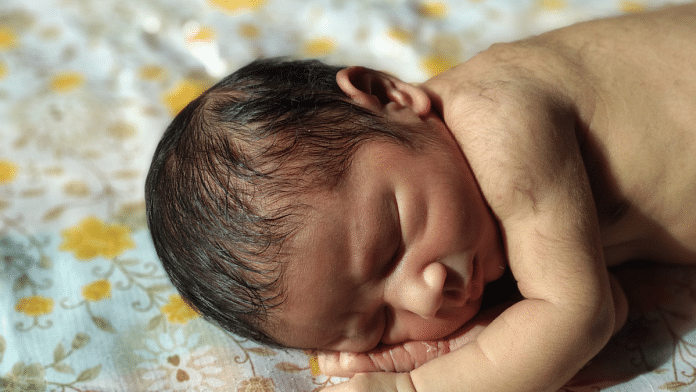New Delhi: As many as 3.02 million preterm babies — the highest in the world — were born in India in 2020, according to a study published in The Lancet journal Saturday and authored by researchers affiliated to the London School of Hygiene & Tropical Medicine, in collaboration with the World Health Organization (WHO) and the United Nations Children’s Fund (originally the United Nations International Children’s Emergency Fund, UNICEF).
Preterm birth is defined as birth in less than 37 weeks of gestation. It’s considered to be one of the main risk factors for neonatal mortality — the death of a newborn before completing four weeks of life, expressed in terms of per 1,000 live births.
In absolute numbers, 30,16,700 kids in the country were born before the completion of 37 weeks of gestation, says the study published on 7 October.
ThePrint has reached the Union Ministry for Health and Family Welfare on email for response on the findings. This report will be updated if and when a response is received.
According to the study published in The Lancet, preterm births are associated with short-term and long-term effects, such as “poor health and growth, intellectual and mental disabilities, and early onset of chronic diseases”, among others.
Since prematurity is the leading cause of death in children under the age of five years, according to WHO, there is an urgent need to strengthen both care for preterm babies as well as prevention efforts — particularly maternal health and nutrition — in order to improve childhood survival.
The study published in The Lancet also shows that a decade has made little difference in the percentage of preterm births in India — while 13 percent of all births in 2020 were reported to be preterm, 13.1 percent were reported to be so in 2010.
According to the study, an estimated 13.4 million babies globally were born preterm in 2020 — around 1 in 10 of all live births.
“India had the highest total number of preterm births in 2020 (3.02 million) and accounted for over 20 percent of all preterm births worldwide, followed by Pakistan, Nigeria, China, Ethiopia, Bangladesh, Democratic Republic of the Congo, and the USA,” the authors noted.
The region reporting the highest percentage of preterm births was southern Asia. Within the region, Bangladesh had the highest rate of preterm births in 2020 (16.2 percent), followed by Pakistan (14.4 percent) and India (13 percent).
Preterm birth rate is the number of preterm births per 100 live births.
Specialists suggest the issue of preterm births in India must be addressed through specific medical interventions.
“While women from the lower socioeconomic status go into premature labour, mainly owing to infections, women from the middle and upper-middle-class backgrounds in urban settings tend to give birth to preterm babies for reasons such as in-vitro fertilisation and higher age during pregnancies,” Anil Batra, a senior consultant neonatologist with Madhukar Rainbow Children’s Hospital in New Delhi, told ThePrint.
Little difference in a decade
According to WHO, for those preterm babies who live, preterm birth also significantly increases the likelihood of suffering major illnesses, disability and developmental delays, and even chronic diseases as adults, like diabetes and heart conditions.
According to the study published in The Lancet, “there has not been a measurable change in preterm birth rate between 2010 (9.8 percent) and 2020 (9.9 percent)” globally.
There were 13.8 million preterm births in 2010 globally, compared to 13.4 million in 2020, the report added.
The Indian government acknowledges that the top cause of child mortality in India, according to its Sample Registration System survey, is premature birth and low birth weight, which cause 29.8 percent of India’s total child mortality. This is followed by pneumonia (17.1 percent), and diarrheal diseases (8.6 percent).
The Sample Registration System is a large-scale demographic sample survey conducted in a random sample of villages and urban blocks in order to obtain reliable estimates of vital rates at the state and national levels.
Despite this, the government says India has made remarkable progress in reducing neonatal mortality ratio (NMR) and under-five mortality ratio (U5MR). USMR refers to the probability of a newborn child dying before reaching the age of five years.
While the NMR came down to 20 per 1,000 live births in 2020 (the last year for which data is available) from 26 in 2014, U5MR was down to 32 in 2020 from 45 in 2014, according to government data.
According to Anil Batra, quoted earlier, early medical intervention can help prevent neonatal deaths. But in India, the health infrastructure and manpower — especially those needed for taking care of neonates, such as neonatal intensive care units, neonatologists, and specialised nursing care — has not kept pace with the country’s growing needs, he said.
“Not only are preterm babies at increased risk of infection at birth, their vital organs are also not fully developed, putting their lives at additional risk,” he told ThePrint. “These babies need intuitive neonatal care at the beginning of their lives, which is not always available.”
(Edited by Uttara Ramaswamy)
Also Read: House panel pulls up govt over lack of separate maternal mortality database for tribals



